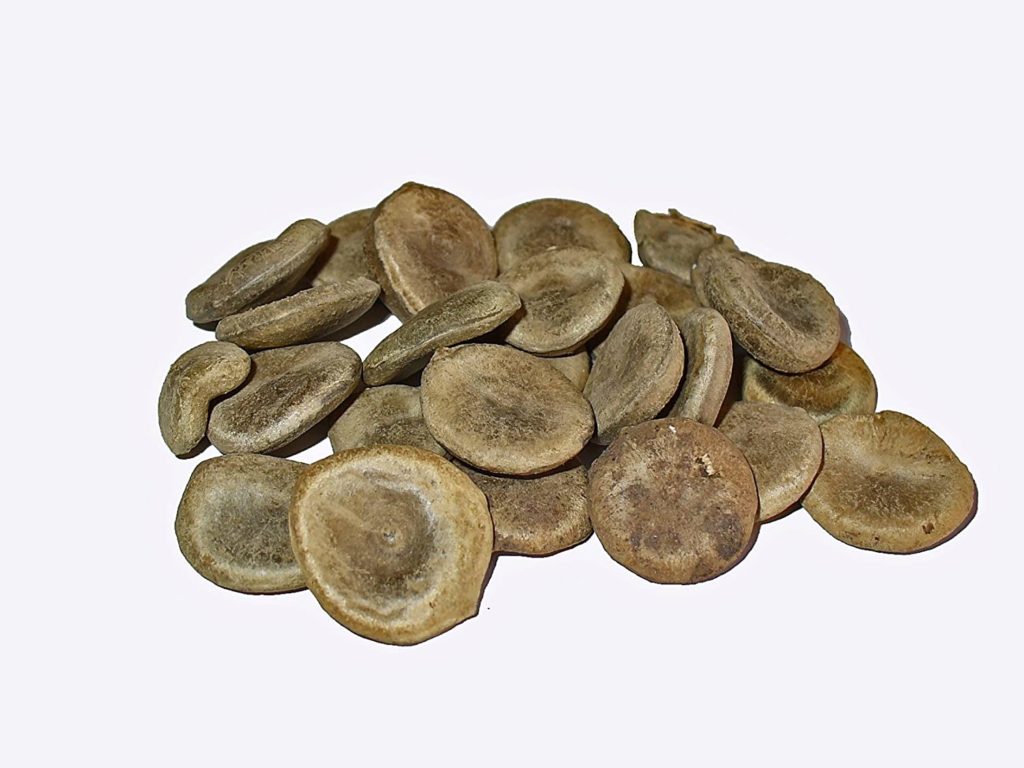
NUX V0MICA (KUCHILA)
• Spinal poison.
• The ripe fruits of the plant contain seeds which are poisonous.
• The seeds are hard and flat about 2 cms in diameter and ½ cms in thickness and slightly convex on one side and concave on the other.
Nux vomica seeds image
• Yellowish-brown in colour and have a shining hard pericarp covered with fine silky hair.
• They are intensely bitter in taste.
• Active principles strychnine, brucine, loganin.
• Strychnine stimulates all parts of the central nervous system and particularly the anterior horn cells of the spinal cord causing greatly increased reflex excitability.
• Normal inhibition of spread of motor cell stimulation is lost so that any slight stimulus such as noise, light, or air causes violent reflex generalised muscle spasms.
• Symptoms and signs:
• If unbroken nux vomica seeds are ingested, they are not poisonous as the hard pericarp is not soluble in the digestive juices.
• If broken seeds are taken or the seeds chewed, there is an intensely bitter taste in the mouth.
• Within 15 minutes to an hour, symptoms of poisoning appear.
• Patient is anxious and restless.
• Stiffness of muscles before typical convulsions occurs.
• These convulsions are at first clonic and then tonic in nature.
• They affect simultaneously both the flexors and extensors.
• During this stage, muscles become so stiff and rigid that the body is arched, with only the back of the head and heels touching the ground. This state is known as opisthotonos.
Opisthotonus Position
• Sometime, the body is curved forward is known as emprosthotonus or sideways pleurothotonos.
• The chest is more or less fixed so that breathing is difficult and cyanosis.
• Blood stained froth may be seen at the mouth.
• The facial muscles contract into a fixed grin, the so-called risus sardonicus and eyes appear prominent and staring.
Risus sardonicus
• After about a minute, the convulsion passes off and the muscles are completely relaxed.
• The patient looks comparatively normal, though somewhat exhausted and breathing is resumed. This remission is only temporary.
• As poisoning progresses, spasms increased in severity, duration, and frequency.
• Death usually due to asphyxia from spasm of respiratory muscles, diaphragm, thoracic and abdominal muscles or from exhaustion due to repetition of spasms.
• The mind remains clear till the end, the patient experiencing extreme pain during convulsions.
• Death is incredibly painful.
• Fatal Dose : 15-30 mg of strychnine or ingestion of one crushed seed. The alkaloid content of one seed of nux vomica is fatal.
• Fatal Period : The usual fatal period is 1-2 hours.
• Treatment:
• The patient should be kept in bed in a dark, quiet room.
• Quick anaesthesia with chloroform, or an intravenous barbiturate if spasms permit, should be effected.
• The stomach is then washed out with a dilute solution of potassium permanganate.
• A suspension of animal charcoal should be introduced to adsorb any free strychnine and afterwards removed.
• Tannic acid may be used if charcoal is not obtainable.
• Barbiturates like phenobarbitone sodium , sodium amytal etc act as antidotes and should be given intravenously in doses of 500- 750 mg.
• Artificial respiration oxygen and supportive therapy may be necessary.
• Post-mortem appearances:
• Asphyxia
• Rigor mortis sets in almost immediately after death and passes off early.
• Seeds may be found in the stomach.
• Strychnine resists putrefaction and can be detected from viscera in exhumed putrefied bodies.
• In deaths from suspected strychnine poisoning, brain and spinal cord should be preserved for analysis in addition to usual viscera.
• Medicolegal Aspects:
• Mostly accidental from its use as an aphrodisiac, from an overdose of a medicinal preparation , or when children eat the seeds out of curiosity.
• Homicide is rare on account of the intensely bitter taste and the convulsion that follow rapidly after ingestion, but has been recorded.
• Suicide with strychnine is rare because death is incredibly painful.
• Nux vomica seeds are used to destroy cattle.
• Strychnine is used to kill stray dogs, as a rodenticide and sometimes as an arrow poison.
Submitted By:
Dr. Jagruti Patel Lecturer at FMT Dept AHMC
With
Dr. Ratna Bhatt Lecturer at HMM Dept AHMC







